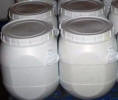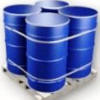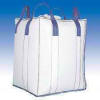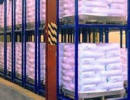| Anmol Chemicals is the pioneer manufacturers of Potassium Ascorbate, Pharmaceutical Excipients Food & Flavor chemicals in India. We offer Halal and Kosher Potassium Ascorbate made in an ISO9001, ISO22000 (FSSC22000) cGMP and GLP certified facility. |
| The units have one or more of the certifications like FDA GMP, ISO 9001, ISO 22000, HACCP, REACH, Kosher & Halal |
Potassium Ascorbate SDS GHS, MSDS Sheet
Specifications of Potassium Ascorbate
Potassium Ascorbate SDS, Safety Data Sheet
MSDS Sheet 04-Feb-22
Section 1: Chemical Product and Identification
Product Name: Potassium Ascorbate or Potassium salt of Ascorbic Acid.
CAS#: 15421-15-5
EINECS EC-No.: 239-432-1
Intended Use: Laboratory and Industrial Manufacturing.
SUPPLIER: As per letterhead.
Section 2: Hazards Identification
GHS, Globally Harmonized System Classification in accordance with 29 CFR 1910
Classification according to Regulation (EC) No 1272/2008
Not a hazardous substance or mixture according to Regulation (EC) No. 1272/2008.
This substance is not classified as dangerous according to Directive 67/548/EEC.
Labeling according to GHS & Regulation (EC) No 1272/2008
| GHS Label Elements NONE |
Signal Word: None
Not considered hazardous by the OSHA Hazard Communication Standard (29 CFR 1910.1200)
Precautionary statements:
P261: Avoid breathing dust/fume/gas/mist/vapors/spray.
P302+P352 - IF ON SKIN: Wash with plenty of soap and water.
P303+P361+P353 - IF ON SKIN (or hair): Remove/Take off immediately all contaminated clothing. Rinse skin with water/shower.
P304 + P340 - IF INHALED: Remove victim to fresh air and keep at rest in a position comfortable for breathing.
P305 + P351 + P338 - IF IN EYES: Rinse cautiously with water for several minutes. Remove contact lenses, if present and easy to do. Continue rinsing.
P337+313: If eye irritation persists get medical advice/attention.
Section 3: Composition and Information on Ingredients
Product Name: Potassium Ascorbate or Potassium salt of Ascorbic Acid.
CAS#: 15421-15-5
EINECS EC-No.: 239-432-1
Section 4: First Aid Measures
Always seek medical attention after first aid measures are provided.
Eye Contact: In case of contact, immediately flush eyes with plenty of water for at least 15 minutes. Get medical attention.
Skin Contact: In case of contact, immediately flush skin with plenty of water. Cover the irritated skin with an emollient. Thoroughly clean shoes and clothes before reuse. Get medical attention.
Inhalation: If inhaled, remove to fresh air. If not breathing, give artificial respiration. If breathing is difficult, give oxygen. Get medical attention.
Ingestion: Do NOT induce vomiting unless directed to do so by medical personnel. Never give anything by mouth to an unconscious person. If copious quantities of this material are swallowed, call a physician immediately.
Section 5: Fire and Explosion Data
Flammability of the Product: It may be combustible at elevated temperature.
Auto-Ignition Temperature: Not available.
Products of Combustion: Potassium oxides CO CO2 and fumes.
Fire Fighting Media and Instructions:
Small Fire: Use DRY chemical powder.
Large Fire: Use water spray, fog, or foam. Avoid water jet.
Extinguishing Media Not recommended: Avoid using solid water jet as it may scatter the fire.
Special Information: In the event of a fire, wear full protective clothing and NIOSH-approved self-contained breathing apparatus with full face piece operated in the pressure demand or other positive pressure mode. At elevated temperatures under fire conditions, it may produce toxic or irritating fumes. Fire-extinguishing work is done from the windward and the suitable fire-extinguishing method according to the surrounding situation is used.
Section 6: Accidental Release Measures
Personal precautions, protective equipment, and emergency procedures: Avoid breathing dust/fumes/gas/mist/vapors/spray. Use individual protective equipment (waterproof boots, suitable protective clothing, safety glasses, etc.). Restrict unprotected personnel from the area. Prevent any contact with hot surfaces. Do not approach facing the wind. Do not touch the spilled material.
Environmental precautions: Do not let the product enter drains, soil, or water sources.
Methods and materials used for containment Clean-up procedures and Storage: Do not inhale dust, vapors, mist, or gas. Avoid dust formation. Contain spilled material. Cover with an inert, non-combustible absorbent material, (e.g., sand, earth, diatomaceous earth, vermiculite). Use a shovel to put the material into a convenient waste disposal container. Finish cleaning by spreading water on the contaminated surface and allow to evacuate as per law.
Section 7: Handling and Storage
Precautions for safe handling: Apply according to good manufacturing and industrial hygiene practices. Ensure proper ventilation. In case of insufficient ventilation, wear suitable respiratory equipment. Wash thoroughly after handling. Do not drink, eat, or smoke while handling. Avoid contact with skin, eyes, and clothing. Minimize dust generation. Avoid breathing dust/fumes/gas/mist/vapors/spray. Use individual protective equipment (waterproof boots, suitable protective clothing, safety glasses, etc.).
Conditions for safe storage, including any incompatibilities: Store in cool, dry, and ventilated area away from heat sources and protected from sunlight in tightly closed original container. Keep air contact to a minimum. Store protected from heat, sparks and ignition sources and incompatible materials. Do not store with incompatible materials like strong oxidizing agents.
Section 8: Exposure Controls/Personal Protection
Exposure Limits: This product does not contain any hazardous materials with occupational exposure limits established by the region-specific regulatory bodies.
Respiratory Protection: Avoid to breath directly on the product. Apply local ventilations when appropriate.
Ventilation System: A system of local and/or general exhaust is recommended to keep employee exposures as low as possible.
Personal Respirators (NIOSH Approved): For conditions of use where exposure to dust or mist is apparent and engineering controls are not feasible, a particulate respirator may be worn.
Skin Protection: Wear protective gloves and clean body-covering clothing.
Eye Protection: Use chemical safety goggles and/or full-face shield where dusting or splashing of solutions is possible. Maintain eye wash fountain and quick-drench facilities in work area.
Other Control Measures: Maintain good housekeeping in work area.
Section 9: Physical and Chemical Properties
Physical state and appearance: Off white to yellow powder.
Odor: Odorless.
Color: Off white to yellow.
Odor threshold: Not available.
pH: Not available.
Relative density: Not available.
Melting point/freezing point: Not available.
Initial boiling point and boiling range: Not available.
Flash point: Not available.
Auto-ignition temperature: Not available.
Decomposition temperature: Not available.
Upper/lower flammability or explosive limits: Not available.
Vapor pressure: Not available.
Vapor density: Not available.
Evaporation rate: Not available.
Flammability (solid, gas): Not available.
Partition coefficient: n-octanol/water: Not available.
Solubility: Soluble in water.
Section 10: Stability and Reactivity Data
Stability: It is stable.
Conditions of Instability: Excessive heat, dust generation
Incompatibility with various substances: Strong oxidizing agents.
Polymerization: Will not occur.
Section 11: Toxicological Information
Toxicity to Animals: No information found.
Carcinogenicity: Not reported as human carcinogen by IARC, ACGIH, OSHA and NTP.
Mutagenic Effects: No information found.
Teratogenic Effects: No information found.
Environmental Toxicity: No information found.
Section 12: Ecological Information
Ecotoxicity: No information found.
Toxicity of the Products of Biodegradation: The product itself and its products of degradation are not toxic.
Persistence and Degradability: No information found.
Bioaccumulation/ Accumulation: No information found.
Mobility: No information found.
Section 13: Disposal Considerations
Waste Disposal: Waste must be disposed of in accordance legal regulations.
Section 14: Transport Information
DOT USA, TDG Canada & ADR/RID Europe: Not regulated.
IMO/IMDG: Not regulated.
ICAO/IATA: Not regulated.
Section 15: Other Regulatory Information
USA:
SARA 311/312 Hazards: See section 2.
California Proposition 65 Chemicals: Not listed.
Section 16 - Additional Information
Potassium AscorbateManufacturers:
Anmol Chemicals
S-8, SARIFA MANSION, 2ND FLANK ROAD, CHINCHBUNDER, MUMBAI 400009, INDIA
TEL: (OFFICE) 91-22-23770100, 23726950, 23774610, 23723564. FAX: 91-22-23728264
e-mail: anmolc@mtnl.net.in
Exports to USA, Canada, UAE, Dubai, South Africa, Tanzania, Kenya, Nigeria, Egypt, Uganda, Turkey, Mexico, Brazil, Chile, Argentina, Europe Netherlands, Italy, Spain, Germany, Portugal, France, Malaysia, Indonesia, Thailand, Vietnam, Korea, Japan, etc.
Copyright and Usual Disclaimer is Applicable. 4 February, 2022



